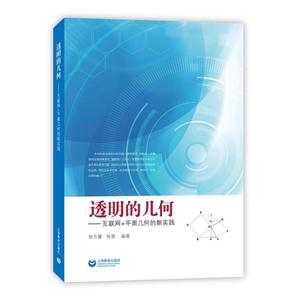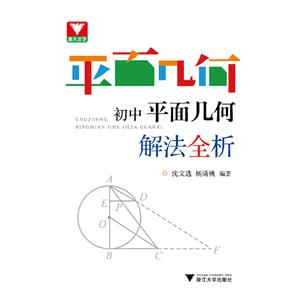
作者:(澳)史迪威
页数:216
出版社:世界图书出版公司
出版日期:2021
ISBN:9787510005312
电子书格式:pdf/epub/txt
内容简介
Geometry used to be the basis of a mathematical education; today it is not even a standard undergraduate topic. Much as I deplore this situation, I welcome the opportunity to make a fresh start, Classical geometry is no longer an adequate basis for mathematics or physics-both of which are becoming increasingly geometric-and geometry can no longer be divorced from algebra, topology, and analysis. Students need a geometry of greater scope, and the fact that there is no room for geometry in the curriculum until the third or fourth year at least allows us to assume some mathematical background.
作者简介
John Stillwell是世界百强名校莫纳什大学(Monash University)数学系教授。
目录
Chapter 1.The Euclidean Plane
1.1 Approaches to Euclidean Geometry
1.2 Isometries
1.3 Rotations and Reflections
1.4 The Three Reflections Theorem
1.5 Orientation-Reversing Isometries
1.6 Distinctive Features of Euclidean Geometry
1.7 Discussion
Chapter 2.Euclidean Surfaces
2.1 Euclid on Manifolds
2.2 The Cylinder
2.3 The Twisted Cylinder
2.4 The Torus and the Klein Bottle
2.5 Quotient Surfaces
2.6 A Nondiscontinuous Group
2.7 Euclidean Surfaces
2.8 Covering a Surface by the Plane
2.9 The Covering Isometry Group
2.10 Discussion
Chapter 3.The Sphere
3.1 The Sphere S2 in R3
3.2 Rotations
3.3 Stereographic Projection
3.4 Inversion and the Complex Coordinate on the Sphere
3.5 Reflections and Rotations as Complex Functions
3.6 The Antipodal Map and the Elliptic Plane
3.7 Remarks on Groups, Spheres and Projective Spaces
3.8 The Area of a Triangle
3.9 The Regular Polyhedra
3.10 Discussion
Chapter 4.The Hyperbolic Plane
4.1 Negative Curvature and the Half-Plane
4.2 The Half-Plane Model and the Conformal Disc Model
4.3 The Three Reflections Theorem
4.4 Isometries as Complex Fnctions
4.5 Geometric Description of Isometries
4.6 Classification of Isometries
4.7 The Area of a Triangle
4.8 The Projective Disc Model
4.9 Hyperbolic Space
4.10 Discussion
Chapter 5.Hyperbolic Surfaces
5.1 Hyperbolic Surfaces and the Killing-Hopf Theorem
5.2 The Pseudosphere
5.3 The Punctured Sphere
5.4 Dense Lines on the Punctured Sphere
5.5 General Construction of Hyperbolic Surfaces from Polygons
5.6 Geometric Realization of Compact Surfaces
5.7 Completeness of Compact Geometric Surfaces
5.8 Compact Hyperbolic Surfaces
5.9 Discussion
Chapter 6.Paths and Geodesics
6.1 Topological Classification of Surfaces
6.2 Geometric Classification of Surfaces
6.3 Paths and Homotopy
6.4 Lifting Paths and Lifting Homotopies
6.5 The Fundamental Group
6.6 Generators and Relations for the Fundamental Group
6.7 Fundamental Group and Genus
6.8 Closed Geodesic Paths
6.9 Classification of Closed Geodesic Paths
6.10 Discussion
Chapter 7.Planar and Spherical TesseUations
7.1 Symmetric Tessellations
7.2 Conditions for a Polygon to Be a Fundamental Region
7.3 The Triangle Tessellations
7.4 Poincarr’s Theorem for Compact Polygons
7.5 Discussion
Chapter 8.Tessellations of Compact Surfaces
8.1 Orbifolds and Desingularizations
8.2 From Desingularization to Symmetric Tessellation
8.3 Desingularizations as (Branched) Coverings
8.4 Some Methods of Desingularization
8.5 Reduction to a Permutation Problem
8.6 Solution of the Permutation Problem
8.7 Discussion
References
Index
1.1 Approaches to Euclidean Geometry
1.2 Isometries
1.3 Rotations and Reflections
1.4 The Three Reflections Theorem
1.5 Orientation-Reversing Isometries
1.6 Distinctive Features of Euclidean Geometry
1.7 Discussion
Chapter 2.Euclidean Surfaces
2.1 Euclid on Manifolds
2.2 The Cylinder
2.3 The Twisted Cylinder
2.4 The Torus and the Klein Bottle
2.5 Quotient Surfaces
2.6 A Nondiscontinuous Group
2.7 Euclidean Surfaces
2.8 Covering a Surface by the Plane
2.9 The Covering Isometry Group
2.10 Discussion
Chapter 3.The Sphere
3.1 The Sphere S2 in R3
3.2 Rotations
3.3 Stereographic Projection
3.4 Inversion and the Complex Coordinate on the Sphere
3.5 Reflections and Rotations as Complex Functions
3.6 The Antipodal Map and the Elliptic Plane
3.7 Remarks on Groups, Spheres and Projective Spaces
3.8 The Area of a Triangle
3.9 The Regular Polyhedra
3.10 Discussion
Chapter 4.The Hyperbolic Plane
4.1 Negative Curvature and the Half-Plane
4.2 The Half-Plane Model and the Conformal Disc Model
4.3 The Three Reflections Theorem
4.4 Isometries as Complex Fnctions
4.5 Geometric Description of Isometries
4.6 Classification of Isometries
4.7 The Area of a Triangle
4.8 The Projective Disc Model
4.9 Hyperbolic Space
4.10 Discussion
Chapter 5.Hyperbolic Surfaces
5.1 Hyperbolic Surfaces and the Killing-Hopf Theorem
5.2 The Pseudosphere
5.3 The Punctured Sphere
5.4 Dense Lines on the Punctured Sphere
5.5 General Construction of Hyperbolic Surfaces from Polygons
5.6 Geometric Realization of Compact Surfaces
5.7 Completeness of Compact Geometric Surfaces
5.8 Compact Hyperbolic Surfaces
5.9 Discussion
Chapter 6.Paths and Geodesics
6.1 Topological Classification of Surfaces
6.2 Geometric Classification of Surfaces
6.3 Paths and Homotopy
6.4 Lifting Paths and Lifting Homotopies
6.5 The Fundamental Group
6.6 Generators and Relations for the Fundamental Group
6.7 Fundamental Group and Genus
6.8 Closed Geodesic Paths
6.9 Classification of Closed Geodesic Paths
6.10 Discussion
Chapter 7.Planar and Spherical TesseUations
7.1 Symmetric Tessellations
7.2 Conditions for a Polygon to Be a Fundamental Region
7.3 The Triangle Tessellations
7.4 Poincarr’s Theorem for Compact Polygons
7.5 Discussion
Chapter 8.Tessellations of Compact Surfaces
8.1 Orbifolds and Desingularizations
8.2 From Desingularization to Symmetric Tessellation
8.3 Desingularizations as (Branched) Coverings
8.4 Some Methods of Desingularization
8.5 Reduction to a Permutation Problem
8.6 Solution of the Permutation Problem
8.7 Discussion
References
Index















